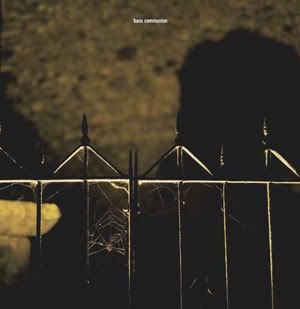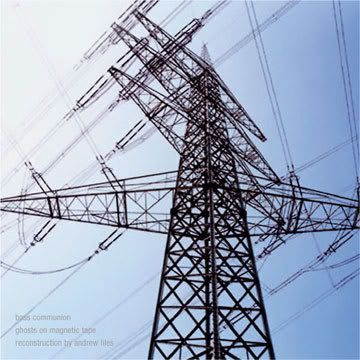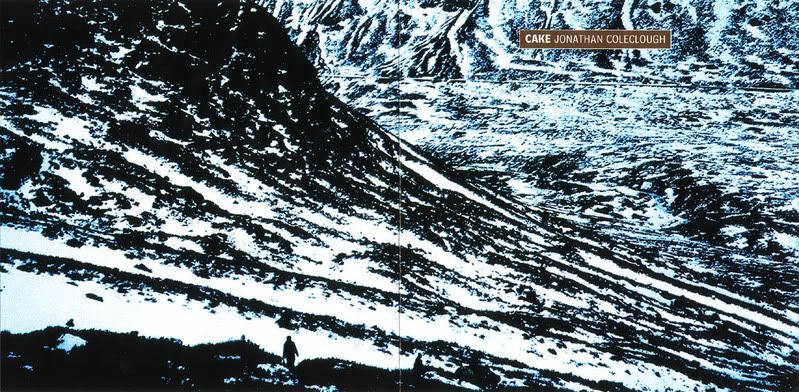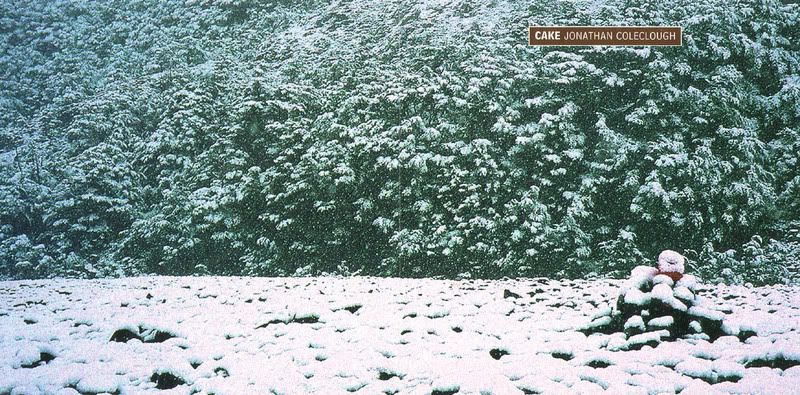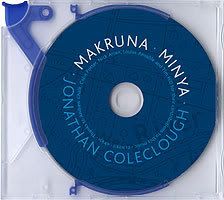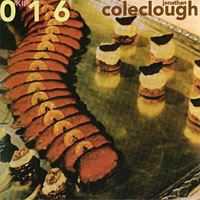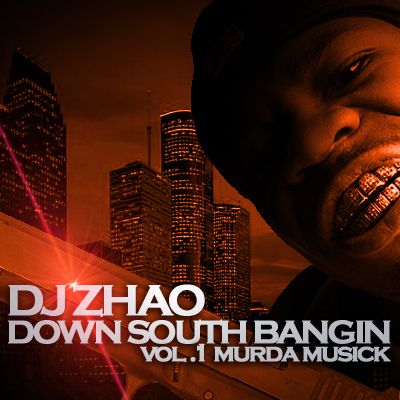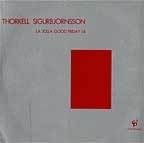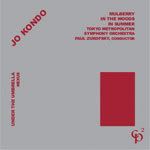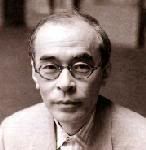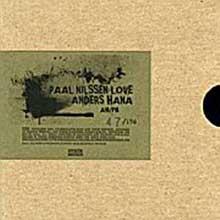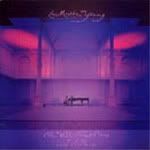here are some recent requests-please enjoy..........
Bang on a Can
Terry Riley -- In C
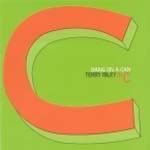
Released: March 1, 2001
Label: Cantaloupe Music
Performers
* Maya Beiser cello
* David Cossin glockenspiel, vibraphone
* Steve Gilewski bass
* Michael Lowenstern soprano saxophone
* Wu Man pipa
* Danny Tunick chimes, marimba
* Lisa Moore piano
* Todd Reynolds violin
* Mark Stewart electric guitar
* Evan Ziporyn clarinet
* Bang on a Can
r(Damn that adams- his link has been delagated to the comment section for shakin' the boat and nauseating the crew and cap'n)
Alan Sondheim, "T'other Little Tune"
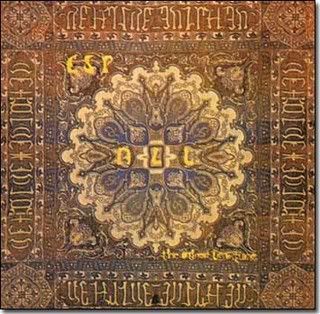
01 Beautiful
02 Varje
03 Messier
04 Rock
05 Day's Eve
06 Bludgeon
07 Think Synk
08 For Planck
09 Breath
10 Slang
11 Steven Crain
12 T'Other Little Tune
Alan Sondheim (Guitar), Alan Sondheim (Piano), Alan Sondheim (Trombone), Alan Sondheim (Marimba), Alan Sondheim (Mellophonium), Alan Sondheim (Recorder), Alan Sondheim (Sax (Soprano)), Alan Sondheim (Moog Synthesizer), Alan Sondheim (Recorder (Bass)), Alan Sondheim (Guitar (Classical)), Alan Sondheim (Main Performer), Alan Sondheim (Hawaiian Guitar), Alan Sondheim (Coordination), Alan Sondheim (Dilruba), Alan Sondheim (Bass Programming), Alan Sondheim (Melodeon), Alan Sondheim (Prepared Piano), Alan Sondheim (Jaltarang), John Emigh (Sax (Tenor)), Gregert Johnson (Flute), Gregert Johnson (Piccolo), Gregert Johnson (Moog Synthesizer), Paul Philips (Trumpet), June Sondheim (Piano), June Sondheim (Vocals), June Sondheim (Voices), Joel Zabor (Drums), Joel Zabor (Tabla), Joel Zabor (Moog Synthesizer), Joel Zabor, John B. Litweiler (Liner Notes), Bernard Stollman (Liner Notes), Tom "Tornado" Klatt (Liner Notes)
r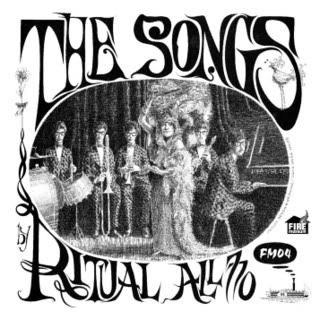
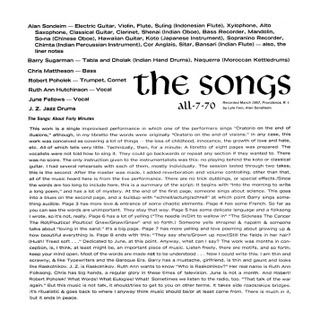
First ever reissue of "The Songs", the debut recording by Alan Sondheim
& Ritual All 770, originally released on Riverboat Records (later
recordings appeared on ESP Disk). Recorded in March 1967 and included
on the legendary Nurse With Wound list of experimental recordings, on
this album Alan Sondheim played Electric Guitar, Violin, Flute, Suling,
Xylophone, Alto Saxophone, Classical Guitar, Clarinet, Shenai, Bass
Recorder, Mandolin, So-na, Hawaiian Guitar, Koto, Sopranino Recorder,
Chimta, Cor Anglais, Sitar and Bansari.
Joined by Barry Sugarman (Tabla, Dholak & Naquerra), Chris Mattheson
(Bass), Robert Poholek (Trumpet & Cornet), Ruth Ann Hutchinson (Vocals),
June Fellows (Vocals) and J.Z. (Jazz Drums); Ritual All 770 were a group
of improvisors living in Providence, Rhode Island. (Perhaps they could
be considered the sonic forebearers of the Fort Thunder scene...)
Rejecting the notion that avant garde music was solely the realm of
isolated academia, they delved fearlessly and joyously into their
music, creating a work that sounds fresh nearly 40 years later.
rALAN WATTS' "THIS IS IT" (1962)
THE FIRST PSYCHEDELIC LP
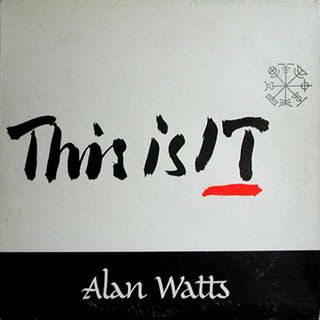
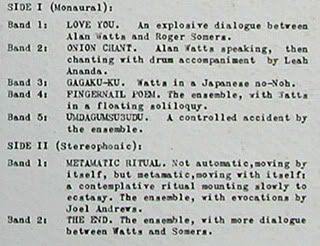
Original release: MEA 1007, Sausalito, California 1962
No production or engineering credits
Participants listed as:
Alan Watts - incantations
Roger Somers - drums and chanting
Leah Ananda - conga drum
Joel Andrews - falsetto and evocations
Henry Jacobs - piano and French horn
William Loughborough - bass marimba and lujon
The LP begins with "an explosive dialogue" wherein Watts and associate Roger Somers rap and ramble over a crude piano and percussion backdrop; an extraordinary intensity rapidly builds and culminates in voices screaming and chanting "loveyouloveyouloveyou", abrutply cut off with a state of the art (for 1962) psychedelic echo effect. It's too tribal to be avantgarde art, too crude to be free jazz, too freaky to be rock'n'roll - it just is "IT", and that's all you can say about IT.
We are then greeted by Watts' delightful voice introducing the "Onion Chant". The confident mid-Atlantic lecturer tone that was such a hit with Bay Area radio listeners briefly recaps a theme from the acid visions of "The Joyous Cosmology", namely that the spiritual student finds himself in an infinite regress of self-realization, where he steps out of his phony egos over and over, like peeling the skin of an onion, until he reaches a point wherein there is almost nothing "genuine" left -- and the subsequent realization isn't moksha, but rather the insight that one is a fake. "He is artifice and insincerity, through and through and through...". This rather harsh message of liberation gives way to an extraordinary uptempo chant with conga drums supporting Watts' seemingly ad libbed trip into an aboriginal tribesman past. You can pick up the word "LSD" early in the chant, but this may be coincidental.
Watts was, among many other things, a great admirer of Japanese culture and tradition, which is echoed in the brief third track of instrumental music. This is followed by an obviously improvised "floating soliloquy" wherein Watts rambles like a true freak about whatever comes through his mind, sounding more like a Shakespeare stage actor zonked on acid than his eloquent lecturer self. "I am so strange in this... queer dark old stewpot..." is just the beginning of the trip, which leads way to some heavy metaphysical poetry about the human body and a rendezvous of friends "high in the sky like the moon". These "Fingernail pairings", supported by feeble avant-jazz snips, is as psychedelic as anything you're ever likely to hear.
Side 1 closes with "Umdagumsubudu", a "controlled accident" with frantic drumming and incomprehensible chanting back and forth, exploring in full the African/Caribbean tribal voodoo feel present throughout the album. It's spooky like an old Nonesuch field recording, except that this is a bunch of white beatnik heads aboard a Sausalito house-boat in 1962, rather than some age-old initiation rite. Uncontrolled laughter and an outburst of Watts coughing puts the listener right inside their freak scene.
Another strand in the colorful ball of "This Is IT" is the influence from religious music of the ecstatic, devotional type. Some of the rants have a tongue-speaking quality, while there is a clear presence of liturgical wailing at the beginning of side 2. This is the "Metamatic Ritual", a 14-minute "contemplative ritual mounting slowly to ecstasy". The whole gang joins in with various percussion instruments and chanting voices half-buried in the soundscape, the total impression being very effective and enchanting. Although improvised, it seems obvious that there was a clear group-mind at play here, much like you can find on tribal acidrock albums such as Beat Of The Earth, Yahowha 13 or Furekaaben; some call-response passages also recall the Merry Pranksters recordings from 1965-66. "Metamatic Ritual" is also the track which best displays the quality of the musicians, with some excellent drum/conga interplay.
"The End" naturally takes us back to the beginning, as it is partly the same track that opened the LP. There is some atmospheric, low-key wailing from Watts and Roger Somers, before the craziness creeps back in, with eerie piano excursions, percussion and incomprehensible ramblings in invented languages; an excellent use of stereo is demonstrated with the chanting voices taking up one channel each (side 1 is mono).
"This Is IT" is an extraordinary album on every level; it must be taken into account in any serious chronicle of psychedelia. Even in 2003 the album appears highly advanced and challenging, its intensity certain to surprise those expecting some bongo-beating beatniks mumbling about nirvana. Timelessness, courage and a sense of absolute freedom makes it a truly essential experience. The fact that it was created by one of the portal figures of the mid-century's spiritual revolution is just one aspect of its importance and appeal.
it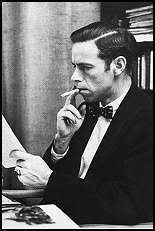
enjoy.............tom7865
